Papers by jessica dalsant
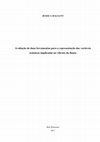
O presente trabalho investigou o vibrato na flauta transversal para determinar que ferramentas de... more O presente trabalho investigou o vibrato na flauta transversal para determinar que ferramentas de analise acustica pudessem descreve-lo de forma abrangente, tendo em vista sua aplicacao no ensino dessa tecnica instrumental. Depois de considerarem-se trabalhos previamente escritos sobre o assunto, resolveu-se focar a analise acustica do vibrato nos seguintes parâmetros acusticos: a profundidade, a taxa, o desvio da frequencia fundamental, a modulacao do envelope espectral, a regularidade e a forma da onda, o modo de ataque e conclusao da nota, os ruidos/nuvens fantasmas, a evolucao no tempo.Esse conjunto de variaveis foi avaliado por dois processos de calculo: primeiro, o programa de analise espectrografica SpectraPro, segundo, o algoritmo proposto pelos departamentos de eletronica e de fisica da UFMG. Ambos os processos sao baseados na Transformada Rapida de Fourier (FFT), mas usam interfaces diferentes.Avaliaram-se dois tipos de amostras: 1) nota longa selecionada de gravacoes come...
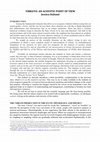
nea, 2011
INTRODUCTION Among the fundamental elements that allow us to recognize a flautist without seeing ... more INTRODUCTION Among the fundamental elements that allow us to recognize a flautist without seeing him are sound quality, vibrato, and the way he uses them: these elements are a bit like a digital fingerprint that differentiates and characterizes him as an unique interpreter. There has been a constant historical evolution trying to describe the flute vibrato in its uses and functions 1 , but both in the ancient treatises and in the most current research works, the emphasis has been placed on aesthetic and stylistic issues at the expense of a more objective analysis of vibrato production and its effects. In what form does the vibrato affect the sound and timbre of the flute? We sought an answer in the scientific literature on the subject, trying to give our contribution to obtain a more complete model of representation of vibrato. As methodological foundation of our research we have used two programs for the analysis of acoustic sound parameters: Spectra-Pro and an Algorithm for the measurement of vibrato fluctuations developed by VIEIRA and SILVA, of the Physics and Electronics Departments of UFMG, Belo Horizonte, Brazil 2. Normally an instrument teacher educates the students to listen and imitate a reference sound, (his own and / or that of famous colleagues, live or in recording), to bring them closer to the canons of "beauty" 3 defined by his own school of thought. When the imitatio maiorum does not lead to the desired improvements, the teacher integrates his indications focusing on explanations and exercises aimed at the body awareness of certain aspects closely related to sound production and control, such as (in the case of wind instruments and singing): alterations of the oral cavity, position of tongue, chin and lips, air velocity, support, resonance points etc. This happens in most cases through the use of metaphors (i.e. imagine to have a hot potato in your mouth) and sometimes through explanations of a more physiological flavor (an illustrious and joking example of both ways, the "Wasabi Technic" by E. Pahud 4). The method we describe introduces a third possibility, complementary to the previous ones, which is to see the sound in real time. This way we try to make available to the students an extra weapon to grasp the correlation between physical sensations and timbral changes in the sound they produce. Allowing to visualize the changes caused by the vibrato in our instrument's tone, this approach helps us to improve its understanding and management, contributing to broaden our tonal and expressive resources. We will do our best to ensure that the scientific language gets the least boring possible, but, being aware that the subject requires to be treated with an appropriate vocabulary, we apologize a priori, relying on the patience and curiosity of the readers.
se é vero che l'efficacia di una terapia (mi riferiró in particolar modo alle terapie di orientam... more se é vero che l'efficacia di una terapia (mi riferiró in particolar modo alle terapie di orientamento analitico) é legata alla possibilitá di una relazione capace di coinvolgere i due protagonisti ad un livello molto profondo, cercheró di mostrare che un tipo molto simile di relazione é chiamato in causa nel rapporto che si instaura tra un insegnante di musica ed i suoi allievi, quando funziona bene. Alludo principalmente al tipo di "processo", alle figure coinvolte ed alle energie emotive che sono mosse.
Questo articolo, basato sulla mia dissertazione "Avaliação de duas ferramentas para a representaç... more Questo articolo, basato sulla mia dissertazione "Avaliação de duas ferramentas para a representação das variáveis acústicas implicadas no vibrato da flauta", illustra come la conoscenza degli effetti acustici del vibrato sul suono del flauto possa essere concretamente applicata nella pratica dello strumento e con quali risvolti.
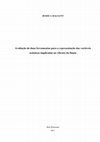
This work investigated the flute vibrato, to determine which analytical tools that represent it i... more This work investigated the flute vibrato, to determine which analytical tools that represent it in a more comprehensive way. Our aim is to use these tools to improve flute instrumental technic.
After considering previously published works on this topic, it has been decided to focus this investigation on the following vibrato acoustical parameters: extent, rate, deviation from the fundamental frequency (F0), regularity and wave shape, attack end ending of the note, use of the vibrato in the attack and ending of the note, noises/ “ghost clouds”, vibrato and spectral envelope evolution in time.
Two different types of tools were tested: first the spectrographic analysis program named SpectraPro, second an algorithm for the measure of vibrato’s fluctuations, proposed by the Physics and Electronics Departments of UFMG. Both tools are based based on the Fast Fourier Transform (FFT), but using different interfaces. Two types of samples have been evaluated: 1) long notes extracted from commercial recording 2) long notes from non commercial recordings, played live by different professional flutists in different dynamics and octaves. The same note was selected from a piece for solos flute, Syrinx, by Claude Debussy (1862-1918). The results of the application of these two tools indicated that the first one is more effective in measuring attack end ending of the note, noises/ “ghost clouds”, vibrato and spectral envelope evolution along the time, but it’s not precise in detecting rate and extent development in time. The second tool revealed to be more precise in measuring regularity, wave shape, rate and extent of F0.
The analysis of different acoustical parameters involved in vibrato allows us to understand what kind of changes happens in flute’s sound and timbre.
To comprehend the various acoustical effects caused by vibrato in flute sound, means giving new technical and pedagogical possibilities for every flutist to improve the use, quality and flexibility of his/her vibrato and timbre. This can help to enrich the sound quality and the expressive possibilities of the flute.
O presente trabalho investigou o vibrato na flauta transversal para determinar que ferramentas de análise acústica pudessem descrevê-lo de forma abrangente, tendo em vista sua aplicação no ensino dessa técnica instrumental. Depois de considerarem-se trabalhos previamente escritos sobre o assunto, resolveu-se focar a análise acústica do vibrato nos seguintes parâmetros acústicos: a profundidade, a taxa, o desvio da frequência fundamental, a modulação do envelope espectral, a regularidade e a forma da onda, o modo de ataque e conclusão da nota, os ruídos/nuvens “fantasmas”, a evolução no tempo.
Esse conjunto de variáveis foi avaliado por dois processos de cálculo: primeiro, o programa de análise espectrográfica SpectraPro, segundo, o algoritmo proposto pelos departamentos de eletrônica e de física da UFMG. Ambos os processos são baseados na Transformada Rápida de Fourier (FFT), mas usam interfaces diferentes.
Avaliaram-se dois tipos de amostras: 1) nota longa selecionada de gravações comerciais; 2) nota longa escolhida de gravações não comerciais feitas por diversos flautistas profissionais em diferentes oitavas e dinâmicas. A nota selecionada foi sempre a mesma e extraída da peça para flauta solo Syrinx, do compositor Claude Debussy (1862-1918). Os resultados da aplicação dessas ferramentas de medição do vibrato indicaram que o primeiro processo é mais efetivo na medição do modo de ataque e conclusão da nota, assim como, ruídos/nuvens “fantasmas”, evolução do vibrato no tempo e envelope espectral, mas não é adequado para rastrear a evolução temporal da taxa e da profundidade das modulações. O segundo processo calcula com maior precisão a regularidade, a forma da onda, a taxa e a profundidade da frequência fundamental (F0). A análise de diferentes variáveis acústicas envolvidas no vibrato permite-nos compreender mudanças que ocorrem no timbre e no som da flauta. Deste modo, conhecendo os diversos efeitos acústicos causados pelo vibrato na flauta, abrem-se possibilidades técnicas e didáticas, que ajudam o flautista a aprimorar o uso, a qualidade e a flexibilidade do seu vibrato, aumentando os recursos timbrísticos e expressivos determinantes da qualidade sonora do instrumento.
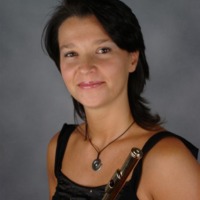
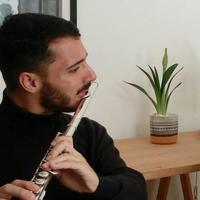


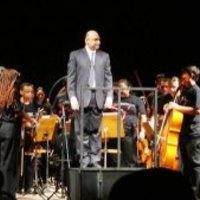




Uploads
Papers by jessica dalsant
After considering previously published works on this topic, it has been decided to focus this investigation on the following vibrato acoustical parameters: extent, rate, deviation from the fundamental frequency (F0), regularity and wave shape, attack end ending of the note, use of the vibrato in the attack and ending of the note, noises/ “ghost clouds”, vibrato and spectral envelope evolution in time.
Two different types of tools were tested: first the spectrographic analysis program named SpectraPro, second an algorithm for the measure of vibrato’s fluctuations, proposed by the Physics and Electronics Departments of UFMG. Both tools are based based on the Fast Fourier Transform (FFT), but using different interfaces. Two types of samples have been evaluated: 1) long notes extracted from commercial recording 2) long notes from non commercial recordings, played live by different professional flutists in different dynamics and octaves. The same note was selected from a piece for solos flute, Syrinx, by Claude Debussy (1862-1918). The results of the application of these two tools indicated that the first one is more effective in measuring attack end ending of the note, noises/ “ghost clouds”, vibrato and spectral envelope evolution along the time, but it’s not precise in detecting rate and extent development in time. The second tool revealed to be more precise in measuring regularity, wave shape, rate and extent of F0.
The analysis of different acoustical parameters involved in vibrato allows us to understand what kind of changes happens in flute’s sound and timbre.
To comprehend the various acoustical effects caused by vibrato in flute sound, means giving new technical and pedagogical possibilities for every flutist to improve the use, quality and flexibility of his/her vibrato and timbre. This can help to enrich the sound quality and the expressive possibilities of the flute.
O presente trabalho investigou o vibrato na flauta transversal para determinar que ferramentas de análise acústica pudessem descrevê-lo de forma abrangente, tendo em vista sua aplicação no ensino dessa técnica instrumental. Depois de considerarem-se trabalhos previamente escritos sobre o assunto, resolveu-se focar a análise acústica do vibrato nos seguintes parâmetros acústicos: a profundidade, a taxa, o desvio da frequência fundamental, a modulação do envelope espectral, a regularidade e a forma da onda, o modo de ataque e conclusão da nota, os ruídos/nuvens “fantasmas”, a evolução no tempo.
Esse conjunto de variáveis foi avaliado por dois processos de cálculo: primeiro, o programa de análise espectrográfica SpectraPro, segundo, o algoritmo proposto pelos departamentos de eletrônica e de física da UFMG. Ambos os processos são baseados na Transformada Rápida de Fourier (FFT), mas usam interfaces diferentes.
Avaliaram-se dois tipos de amostras: 1) nota longa selecionada de gravações comerciais; 2) nota longa escolhida de gravações não comerciais feitas por diversos flautistas profissionais em diferentes oitavas e dinâmicas. A nota selecionada foi sempre a mesma e extraída da peça para flauta solo Syrinx, do compositor Claude Debussy (1862-1918). Os resultados da aplicação dessas ferramentas de medição do vibrato indicaram que o primeiro processo é mais efetivo na medição do modo de ataque e conclusão da nota, assim como, ruídos/nuvens “fantasmas”, evolução do vibrato no tempo e envelope espectral, mas não é adequado para rastrear a evolução temporal da taxa e da profundidade das modulações. O segundo processo calcula com maior precisão a regularidade, a forma da onda, a taxa e a profundidade da frequência fundamental (F0). A análise de diferentes variáveis acústicas envolvidas no vibrato permite-nos compreender mudanças que ocorrem no timbre e no som da flauta. Deste modo, conhecendo os diversos efeitos acústicos causados pelo vibrato na flauta, abrem-se possibilidades técnicas e didáticas, que ajudam o flautista a aprimorar o uso, a qualidade e a flexibilidade do seu vibrato, aumentando os recursos timbrísticos e expressivos determinantes da qualidade sonora do instrumento.
After considering previously published works on this topic, it has been decided to focus this investigation on the following vibrato acoustical parameters: extent, rate, deviation from the fundamental frequency (F0), regularity and wave shape, attack end ending of the note, use of the vibrato in the attack and ending of the note, noises/ “ghost clouds”, vibrato and spectral envelope evolution in time.
Two different types of tools were tested: first the spectrographic analysis program named SpectraPro, second an algorithm for the measure of vibrato’s fluctuations, proposed by the Physics and Electronics Departments of UFMG. Both tools are based based on the Fast Fourier Transform (FFT), but using different interfaces. Two types of samples have been evaluated: 1) long notes extracted from commercial recording 2) long notes from non commercial recordings, played live by different professional flutists in different dynamics and octaves. The same note was selected from a piece for solos flute, Syrinx, by Claude Debussy (1862-1918). The results of the application of these two tools indicated that the first one is more effective in measuring attack end ending of the note, noises/ “ghost clouds”, vibrato and spectral envelope evolution along the time, but it’s not precise in detecting rate and extent development in time. The second tool revealed to be more precise in measuring regularity, wave shape, rate and extent of F0.
The analysis of different acoustical parameters involved in vibrato allows us to understand what kind of changes happens in flute’s sound and timbre.
To comprehend the various acoustical effects caused by vibrato in flute sound, means giving new technical and pedagogical possibilities for every flutist to improve the use, quality and flexibility of his/her vibrato and timbre. This can help to enrich the sound quality and the expressive possibilities of the flute.
O presente trabalho investigou o vibrato na flauta transversal para determinar que ferramentas de análise acústica pudessem descrevê-lo de forma abrangente, tendo em vista sua aplicação no ensino dessa técnica instrumental. Depois de considerarem-se trabalhos previamente escritos sobre o assunto, resolveu-se focar a análise acústica do vibrato nos seguintes parâmetros acústicos: a profundidade, a taxa, o desvio da frequência fundamental, a modulação do envelope espectral, a regularidade e a forma da onda, o modo de ataque e conclusão da nota, os ruídos/nuvens “fantasmas”, a evolução no tempo.
Esse conjunto de variáveis foi avaliado por dois processos de cálculo: primeiro, o programa de análise espectrográfica SpectraPro, segundo, o algoritmo proposto pelos departamentos de eletrônica e de física da UFMG. Ambos os processos são baseados na Transformada Rápida de Fourier (FFT), mas usam interfaces diferentes.
Avaliaram-se dois tipos de amostras: 1) nota longa selecionada de gravações comerciais; 2) nota longa escolhida de gravações não comerciais feitas por diversos flautistas profissionais em diferentes oitavas e dinâmicas. A nota selecionada foi sempre a mesma e extraída da peça para flauta solo Syrinx, do compositor Claude Debussy (1862-1918). Os resultados da aplicação dessas ferramentas de medição do vibrato indicaram que o primeiro processo é mais efetivo na medição do modo de ataque e conclusão da nota, assim como, ruídos/nuvens “fantasmas”, evolução do vibrato no tempo e envelope espectral, mas não é adequado para rastrear a evolução temporal da taxa e da profundidade das modulações. O segundo processo calcula com maior precisão a regularidade, a forma da onda, a taxa e a profundidade da frequência fundamental (F0). A análise de diferentes variáveis acústicas envolvidas no vibrato permite-nos compreender mudanças que ocorrem no timbre e no som da flauta. Deste modo, conhecendo os diversos efeitos acústicos causados pelo vibrato na flauta, abrem-se possibilidades técnicas e didáticas, que ajudam o flautista a aprimorar o uso, a qualidade e a flexibilidade do seu vibrato, aumentando os recursos timbrísticos e expressivos determinantes da qualidade sonora do instrumento.